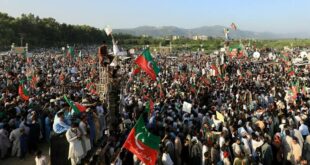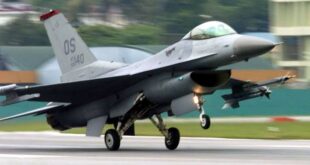By Asim Qadeer Rana
Israel’s air strikes on the besieged, defenseless Gaza continue with uneven fierceness, killing 3,785 Palestinians, including hundreds of children. Israel is amassing troops and tanks on its border with Gaza in preparation for a ground invasion, after ordering some one million people to evacuate from the northern half of the land strip
US President Joe Biden and UK Prime Minister Rishi Sunak traveled to Israel to declare their support for the Jewish nation’s “right to defend itself”. Mr. Biden’s visit came hours after an attack on a hospital in Gaza left at least 500 dead. The hospital that was sheltering thousands was hit by Israeli jets and Israel claimed that a rocket fired by Palestinian militants caused the explosion.
While truth is the first casualty of war, a vengeful Israel’s mindless bombing of a tiny, blockaded enclave is pushing its 2.3 million people into an unimaginable struggle of life and death, even as the powerful nations are either looking away or busy backing Israel’s campaign.
Mr. Biden announced that Israel has allowed letting some 20 trucks of humanitarian aid into Gaza from Egypt. While any aid is welcome, 20 trucks of aid for two million people is, as the International Federation of Red Cross and Red Crescent Societies put it, “a drop in the ocean”.
Collectively punishing Gaza in the name of fighting Hamas and carrying out indiscriminate bombing that is killing hundreds a day do not make Israel any better than Hamas. Moreover, this approach of the Israeli state towards the Palestinians has neither improved Israel’s security nor helped the stakeholders find a solution to the crisis.
Israeli Prime Minister Benjamin Netanyahu, on whose watch the country’s biggest security crisis unfolded, says he will “crush” Hamas. However, Israel does not have easy options. Reoccupying Gaza would lead to a prolonged urban war of attrition.
Hamas rose to prominence using the vacuum left by the failures of Fatah and the Palestinian Liberation Organization. If Israel manages to diminish Hamas’s influence in Gaza, nobody knows what comes next as the Palestine question, which is the ongoing Israeli occupation, remains unaddressed.
In an ideal world, the U.S., the most powerful country that is ruled by a President who has stated his commitment to “a foreign policy centered on human rights”, should be enraged by what its ally is doing and apply pressure on Tel Aviv to stop the bombing and start talking, involving regional powers. However, as that is a non-possibility as of now, Israel is set to continue the attacks with impunity, multiplying the woes of millions of Palestinians.
Some 400 Palestinians were killed in a single day by Israeli air attacks on Gaza, according to Palestinian health officials. The Gaza Strip has sustained widespread destruction as the Israeli military has bombarded the besieged enclave of 2.3 million people for more than two weeks. Even its south, which Israel had declared a safe zone has not been spared.
Satellite imagery and photographs show entire neighborhoods have been leveled with many hospitals, schools, places of worship, and homes damaged or destroyed by Israeli land, sea, and air attacks.
Bordered by Israel and Egypt on the Mediterranean coast, the Gaza Strip is 365 sq km (141 sq miles). At only 41km (25 miles) long, it can take less than an hour to drive from Beit Hanoon in the north to Rafah in the south.
The Palestinian enclave has a population of 2.3 million people, including 1.7 million refugees who were ethnically cleansed from areas that now form part of Israel. Most refugees live in or near Gaza’s eight refugee camps.
North Gaza extends for 10km (6 miles) and shares the only crossing into Israel through Beit Hanoon, also known as the Erez crossing. North Gaza is home to the Jabalia refugee camp, the largest in the strip.
The 61sq-km (24sq-mile) area is home to 440,000 people and includes the following communities and neighborhoods: Beit Lahiya, Beit Hanoon, Jabalia refugee camp, Madinat al-Awda and Jabalia al-Balad.
The Israeli military has repeatedly hit the Jabalia camp, killing more than 150 people. The camp houses three United Nations-run schools, which have been converted into shelters for hundreds of displaced families.
Gaza City is the largest and most populous city within the Gaza Strip with more than 750,000 residents. Located along Gaza’s Mediterranean coastline are the neighborhoods of Gaza Harbour, the Shati refugee camp, and Northern and Southern Rimal.
At the heart of the Rimal neighborhoods is al-Shifa Hospital, the largest medical facility in the Gaza Strip. Tens of thousands of displaced Palestinians are sheltering at the hospital, where Palestinian doctors are warning of an impending infectious disease outbreak due to overcrowding.
Surrounding the hospital are several UN compounds, including the Relief and Works Agency for Palestine Refugees (UNRWA), the Office of the UN Special Coordinator for the Middle East Peace Process (UNSCO), and the UN Development Program (UNDP).
Gaza’s top universities – including the Islamic University of Gaza, Al-Azhar University-Gaza, and Al-Aqsa University, which are just a few hundred meters apart – are also located in Rimal. On October 7, Israeli warplanes destroyed the Palestine Tower, a 14-storey residential tower in Rimal, reducing it to rubble.
Israeli attacks have targeted the Shati refugee camp, also known as Beach Camp, several times, terrifying its 90,000 inhabitants living on 0.52 sq km (0.2 sq miles) of land. On October 9, Israeli strikes destroyed the Yassin Mosque, one of at least 11 mosques that have been destroyed since October 7.
Farther east is the neighborhoods of Sheikh Radwan, al-Nasr, al-Darraj, al-Tuffah, al-Sabra, and Tal al-Hawa. Israeli strikes hit areas near al-Quds Hospital in Tal al-Hawa. More than 8,000 Palestinians had taken refuge at the hospital.
Just north of the Zeitoun neighborhood is Gaza’s Old City, which is home to several historical sites, including the Great Omari Mosque, known as Gaza’s Great Mosque, and two of Gaza’s churches: St Philip the Evangelist Chapel and St Porphyrius Church.
On Tuesday, a massive blast at al-Ahli Arab Hospital, also in the Old City, killed nearly 500 Palestinians, many of whom were taking shelter from Israeli bombing. The Ministry of Health in Gaza said the blast was caused by an Israeli air raid. Israel has attributed the explosion to a misfired rocket launched by the Palestinian Islamic Jihad (PIJ) armed group. The PIJ has denied the allegation.
Two days later, an Israeli air attack killed at least 18 people who were sheltering in the St Porphyrius Church, Gaza’s oldest church, which was built between the 1150s and 1160s. A Palestinian pastor has called the bombing of St Porphyrius, where hundreds of people had taken refuge, a “war crime”.
One of the largest neighborhoods in Gaza City is Shujaiya, which in Arabic means “courage”. Shujaiya has experienced extensive destruction in past Israeli military offensives.
On the outskirts of Gaza City are the neighborhoods of al-Zahra, al-Mughraqa, and Juhor ad-Dik, which have also been hit by Israeli raids. In al-Zahra, Israeli attacks have leveled at least 10 buildings and left thousands of people either trapped in the rubble or awaiting medical care.
Beginning at Wadi Gaza, a river that divides Gaza roughly into north and south, Deir el-Balah is named after the Monastery of the Date Palm and is one of Gaza’s largest agricultural producers. Gaza’s only operating power plant is located along the district’s boundary with Gaza City. Deir el-Balah is also home to four out of Gaza’s eight refugee camps: Nuseirat, al-Bureij, al-Maghazi, and Deir el-Balah.
Israeli air raids have bombed a number of bakeries in Gaza, killing dozens of people and injuring hundreds who were queueing to buy bread. One such bakery was the Al Nuseirat Bakery. The other neighborhoods in Deir el-Balah include Az-Zawayda, al-Musaddar, Wadi as-Salqa, and al-Ma’ani.
Khan Younis is Gaza’s largest governorate by area at 108 sq km (42 sq miles) and is home to 430,000 people. At its center is the Khan Younis refugee camp, where about 90,000 people live. The Israeli army has continued striking Khan Younis and other southern areas despite ordering people in Gaza to move south. Thousands of Palestinians have crowded into squalid tent camps in southern Gaza, many without food or water.
Other neighborhoods in Khan Younis include al-Qarara, Abasan al-Jadida (as-Saghir), al-Sureij, Bani Suheila, Abasan al-Kabira, Khuza’a, Qa’ al-Qurein, al-Mawasi, Qizan an-Najjar, Qa’ al-Kharaba, al-Fukhkhari and Umm Kameil.
Rafah is the southernmost district of Gaza with a population of about 275,000. Rafah is also the name of the crossing with Egypt that is located there. On Saturday, a convoy of 20 trucks carrying humanitarian aid entered the besieged Gaza Strip through the Rafah crossing.
The situation inside Gaza is dire. Not only is there no food, but there is no water, electricity, or fuel. Moreover, that combination is not only catastrophic but can lead to more starvation and disease as well.
Israel has sealed off the territory, forcing Palestinians to ration food and drink filthy water from wells. Hospitals said they are running low on medicine and fuel for emergency generators during a Gaza-wide blackout. According to the UN, sanitation facilities, water wells, reservoirs, and pumping stations have suffered damage due to incessant air strikes.
Those who are able to get through the Rafah crossing must then make a six- to eight-hour journey through the Sinai Desert, passing several Egyptian checkpoints on their way to Cairo, about 350km (220 miles) away.
The neighborhoods in Rafah include Umm al-Kilab, al-Mawasi, al-Qarya al-Suwydiya, Tel es-Sultan, Rafah refugee camp, al-Bayuk, and Shokat as-Sufi. The international community had better stop Israel now as the Middle East cannot take another major war.
 Pride News Daily NEWS
Pride News Daily NEWS





